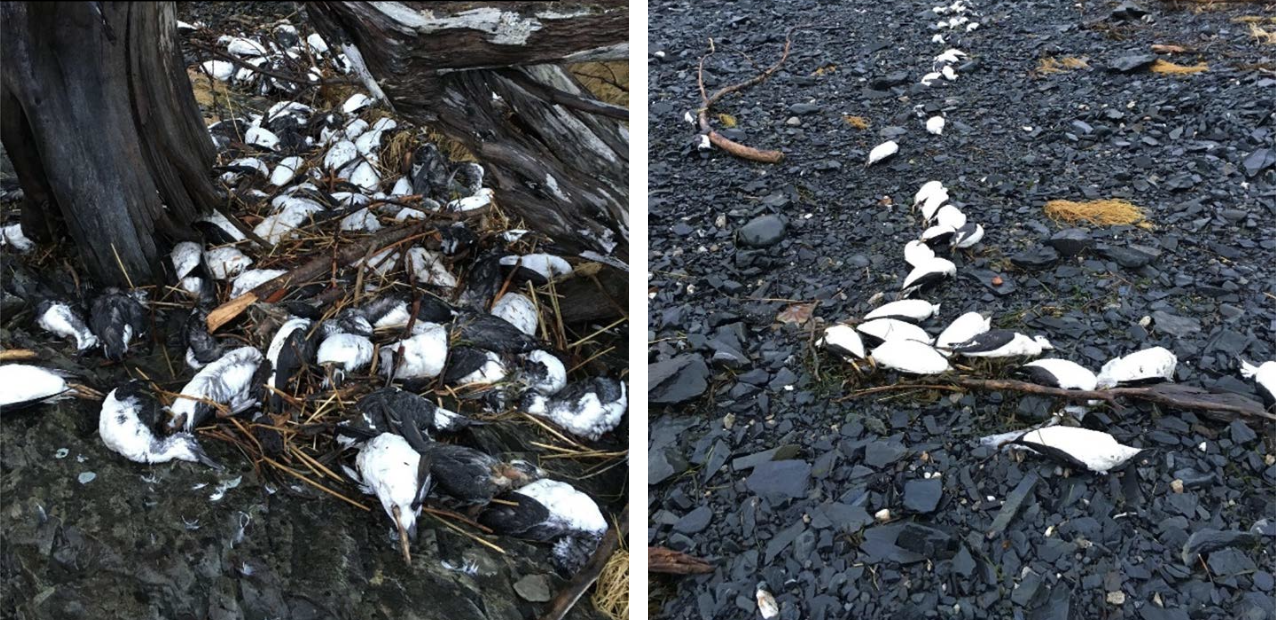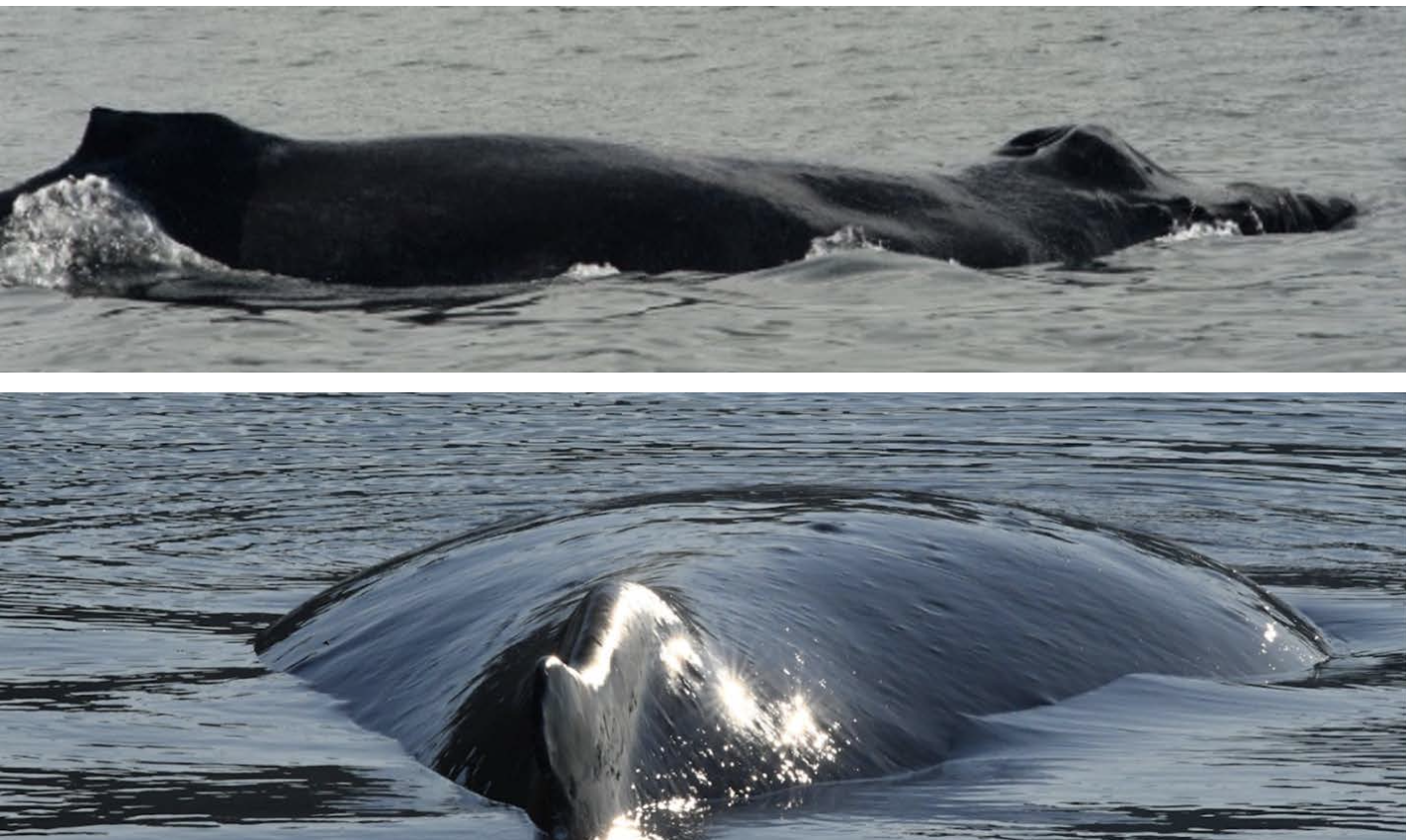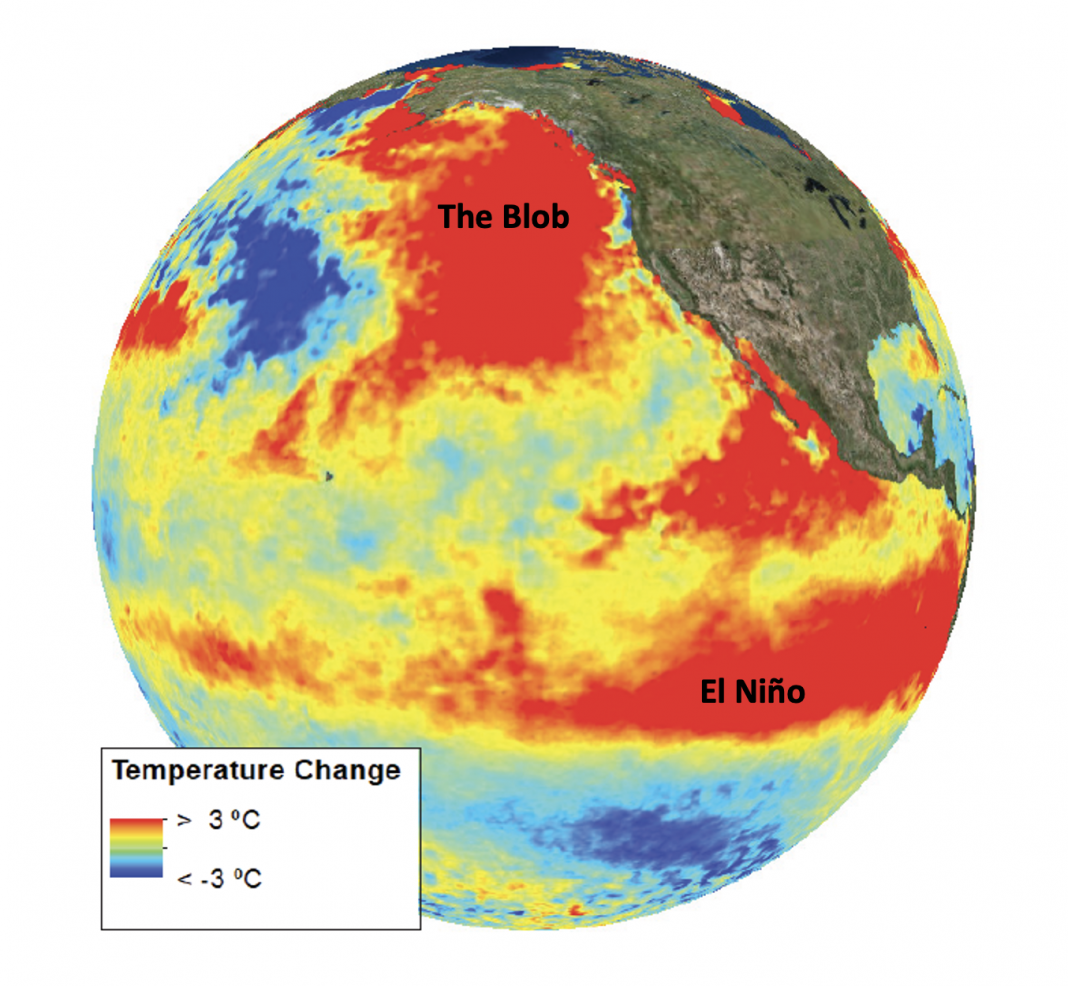Lauren Bien from Prince William Sound Science Center and Mayumi Arimitsu from USGS, Alaska Science Center and additional contributors, John Moran and Rob Suryan, Alaska Fisheries Science Center explain how seabirds and humpback whales provide early warning signals during extreme marine heatwaves
Between 2014 and 2016, an extreme marine heatwave struck the North Pacific Ocean, affecting nearshore and pelagic (offshore, open-ocean) ecosystems from Southern California to Alaska. This unprecedented event, characterized by unusually warm ocean temperatures over a large area, was the longest-duration marine heatwave recorded to date. The Gulf of Alaska endured some of the most severe consequences of this heatwave, now known as the Pacific Marine Heatwave or “the Blob” (Fig. 1).
Marine heatwaves, like the Blob, are increasing in frequency and intensity over time, and they are capable of causing large-scale disruptions to marine ecosystems (Oliver et al. 2018). Understanding the impacts of marine heatwaves on biological communities will support management decisions in light of the increased occurrence of these events across the world’s oceans in recent decades.
A view from the surface
Pelagic ecosystems are dynamic, three-dimensional, and vast, therefore making them challenging to study. However, studying animals known as indicator species, which are responsive to environmental changes, have important ecological functions, and are easier to observe, can provide clues about the status of other species or changes in the physical environment.
During the prolonged and harsh Blob conditions, top predators in the Gulf of Alaska pelagic ecosystem showed alarming signs of distress, indicating large-scale disruptions below the surface. Humpback whales displayed changes in foraging behavior and faced unusual mortality events, and seabirds faced massive die-offs and breeding failures. Both groups experienced extreme starvation (Arimitsu et al. 2021, Gabriele et al. 2022).
Between May 2015 and April 2016, approximately 62,000 Common murre (a fish-eating seabird, typically resilient to changing environmental conditions) carcasses were found along the West Coast of North America (Fig. 2). However, previous work has shown that only a small fraction of carcasses are recovered, and so scientists estimated at the time that the actual die-off numbers during this event were between 500,000 and 1.2 million murres. The carcasses showed signs of starvation with little to no body fat, protruding keels (breastbones), and empty stomachs. The impact was particularly devastating for breeding-age adult murres, who will forgo breeding when food is scarce.
The circumstances leading to starvation combined with the loss of breeding-age adults led to widespread breeding colony failures from California to the Arctic (Piatt et al. 2020). Other seabird species, such as Cassin’s auklets, tufted puffins, and shearwaters, suffered similar fates during and after the Blob.
Whales also felt the devastating effects of the Blob. Between 2014 and 2017, researchers saw a dramatic drop in the number of humpback whales in the Gulf of Alaska. Not only were fewer whales observed, but the whales observed during that time were notably malnourished – skinny, with visible ribs, scapula, and vertebrae (Fig. 3). Similarly, the number of whale calves fell during this time, and for the first time ever recorded, 2018 was considered a total reproductive failure for these whales (Gabriele et al. 2022).

Completing the picture
Usually, the dramatic responses of seabirds and whales could only hint at or indicate a larger disruption in the ecosystem. However, in this case, a comprehensive long-term monitoring program brought together scientists from various agencies and organizations to monitor changes in the marine ecosystem. Gulf Watch Alaska’s ecosystem-wide approach, examining links between environmental factors, the pelagic ecosystem, and the nearshore ecosystem provides data to quantify change (e.g., Suryan et al. 2023).
Research findings from Gulf Watch Alaska revealed dramatic changes in the pelagic food web in response to the Blob (Arimitsu et al. 2021). As ocean temperatures rose, the available zooplankton species, small animals near the base of the marine food web, shifted towards smaller and less nutritious prey species for forage fish. Forage fish, small fish that are important prey to predators such as fish, seabirds, and whales, experienced large changes in size, age, growth, and abundance during the heatwave (Arimitsu et al. 2021). For example, during the Blob, Pacific sand lance, an important prey species for common murres and humpback whales, experienced unusually slow growth and were 89% lower in fat content than normal (von Biela et al. 2019). The forage fish also faced increased predation from larger fish experiencing increased metabolism brought on by warmer ocean temperatures. The one-two punch of poor quality food and increased predation during the Blob led to the collapse of multiple important forage fish species populations, creating a disruption in the flow of energy to animals that feed further up in the pelagic food web.
Biological response to the blob persisted for years after the onset of the heatwave (Suryan et al. 2021). The changes in the zooplankton community and subsequent lack of forage fish ultimately lead to starvation among the seabirds, whales, and other top predators in the Gulf of Alaska marine ecosystem.

Looking forward
As the ocean faces ongoing changes, long-term monitoring provides data to support greater understanding of complex ecosystem responses. The differing mechanisms and vulnerabilities across marine ecosystems identified here provide examples of how monitoring efforts can be useful for anticipating change in Alaska’s marine ecosystems.
Any use of trade, firm, or product names is for descriptive purposes only and does not imply endorsement by the U.S. Government.

This work is licensed under Creative Commons Attribution-NonCommercial-NoDerivatives 4.0 International.


